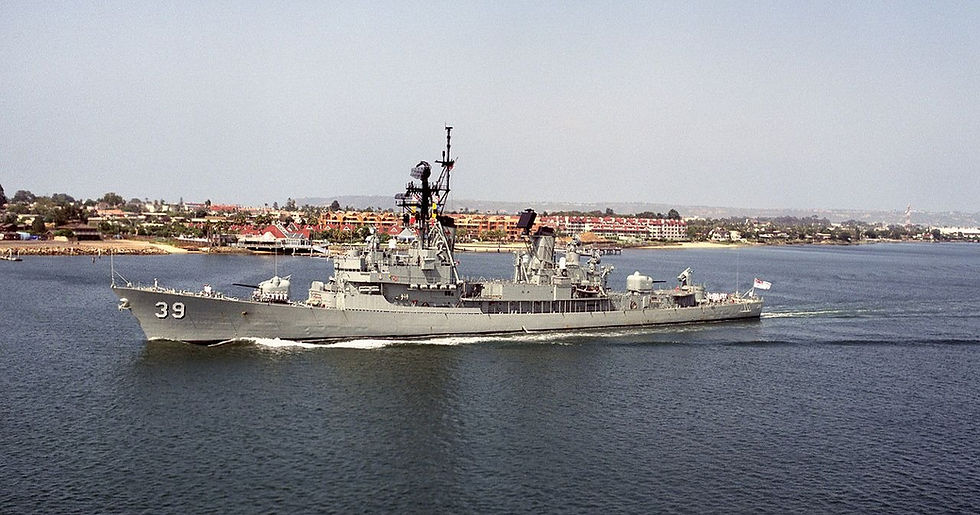HMAS Hobart DDG39
- Nepean Naval Museum

- Mar 12, 2023
- 3 min read
HMAS Hobart DDG 39, named after the city of Hobart, Tasmania, is the lead ship of the Hobart Class air warfare destroyers used by the Royal Australian Navy.

The Australian Air Warfare Destroyer (AWD) project commenced in 2000, to replace the Adelaide-class frigates and restore the capability last exhibited by the Perth-class destroyers.
The AWD Alliance (a consortium of the Defence Materiel Organisation (DMO), shipbuilder ASC, and combat system designer Raytheon) was created to oversee the acquisition project.
In August 2005, Gibbs & Cox's Evolved Flight II Arleigh Burke-class destroyer concept and the Navantia-designed Álvaro de Bazán-class frigate were selected from the initial round of tendering for further study.
Although the Arleigh Burke concept was larger, better-armed, and more capable on paper, the Álvaro de Bazán class was selected June 2007 as the basis of the AWD as they had seen active service, could be in Australian service earlier and were cheaper. Three ships were ordered on 4 October 2007, with an unexercised option for a fourth.
Hobart was ordered in 2007, but errors and delays in construction have caused extensive schedule slippage. Despite commissioning initially planned for December 2014, the ship was not laid down until September 2012, and launched in May 2015. Department of Defence accepted delivery of HMAS Hobart on 16 June 2017. The ship was commissioned on 23 September 2017
The ship was assembled from 31 pre-fabricated modules ('blocks'): 12 for the hull, 9 for the forward superstructure, and 10 for the aft superstructure. Modules were fabricated by ASC in South Australia, BAE Systems Australia in Victoria, and Forgacs Group in New South Wales, with final assembly of the ship at ASC's shipyard in Osborne, South Australia. Delays and project slippage resulted in the redistribution of block construction across the three shipbuilders, and the bow hull block was constructed by Navantia.

Hobart has a full-load displacement at launch of 6,250 tonnes (6,150 long tons; 6,890 short tons), a length overall of 147.2 metres (483 ft), a maximum beam of 18.6 metres (61 ft), and a draught of 5.17 metres (17.0 ft). The combined diesel or gas turbine (CODOG) propulsion arrangement consists of two General Electric Marine model 7LM2500-SA-MLG38 gas turbines, each generating 17,500 kilowatts (23,500 hp), and two Caterpillar Bravo 16 V Bravo diesel engines, each providing 5,650 kilowatts (7,580 hp). These drive two propeller shafts, fitted with Wärtsilä controllable pitch propellers.
The ships' maximum speed is over 28 knots (52 km/h; 32 mph), with a range of over 5,000 nautical miles (9,300 km; 5,800 mi) at 18 knots (33 km/h; 21 mph); although slower than equivalent designs, the greater range and endurance is more important for Australian operating conditions. She is also fitted with a bow thruster, transversal propulsion device built into, or mounted to, either the bow or stern, of a ship or boat to make it more maneuverable.
The standard ship's company is 186-strong, plus 16 additional personnel to operate and maintain the ship's helicopter, with maximum accommodation for 234.

The destroyer's main weapon is a 48-cell Mark 41 Vertical Launch System, capable of firing RIM-66 Standard 2 anti-aircraft missile or quad-packed RIM-162 Evolved Sea Sparrow point-defence missiles, with likely upgrades to carry RIM-174 Standard 6 anti-aircraft missiles and Tomahawk cruise missiles. This will be supplemented by two four-canister Harpoon anti-ship missile launchers, and a BAE Systems 5-inch/62 calibre Mark 45 gun. Two Mark 32 Mod 9 two-tube launchers fitted with Eurotorp MU90 torpedoes will be carried for anti-submarine warfare . For close-in defence, an aft-facing Phalanx CIWS system and two M242 Bushmaster autocannons in Typhoon mounts sited on the bridge wings are fitted. A single MH-60 Romeo Seahawk will be embarked.
The ship's sensors are built around the Aegis combat system, with a Lockheed Martin AN/SPY-1D(V) S-band main radar, a Northrop Grumman AN/SPQ-9B X-band search radar, a Raytheon Mark 99 fire-control system with two continuous wave illuminating radars for missile direction, and two L-3 Communications SAM Electronics X-band navigation radars. An Ultra Electronics Sonar Systems' Integrated Sonar System is fitted, which includes a hull-mounted sonar and a towed variable depth sonar built up from a quad directional active-passive receive array, a passive torpedo detection array and a high-powered towed sonar source. Other sensors include an Ultra Electronics Series 2500 electro-optical director, a Sagem VAMPIR IR search and track system, and Rafael Toplite stabilised target acquisition sights for each ship's Typhoons. Electronic warfare sensors consist of the ITT EDO Reconnaissance and Surveillance Systems ES-3701 electronic support measures (ESM) radar, a SwRI MBS-567A communications ESM system, an Ultra Electronics Avalon Systems multi-purpose digital receiver, and a Jenkins Engineering Defence Systems low-band receiver. Countermeasures include four launchers for Nulka decoy missiles, plus four six-tube launchers for radio frequency, infrared, and underwater acoustic decoys.



Comments